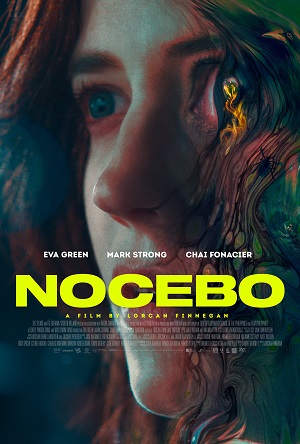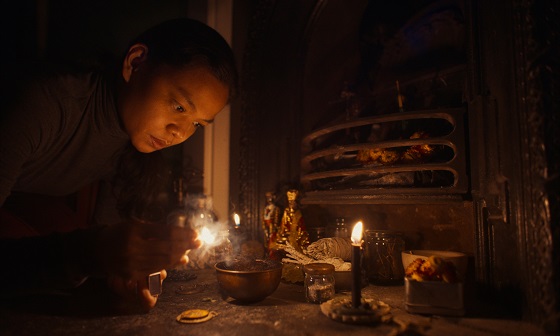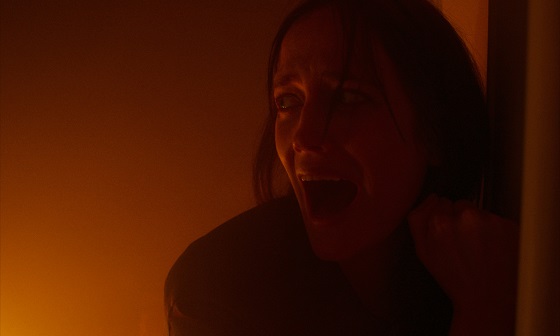

[Rating: Solid Rock Fist Up]
In Theaters Friday, Nov. 4
Every adult has seen a ghost, at least figuratively. Live long enough and the past will catch up, revealing an injury or memory that will continue to haunt for as long as a person retains any feelings or recollections. Nocebo is a movie about the ways people suffer, and what it means to come to terms with the chronic ailments that some doctors and medicines can’t reach.
When the audience meets children’s fashion designer Christine (Eva Green), she’s getting ready for a runway show for her new line. Focused, driven, and possessed of a pleasant disposition, Christine takes a call the audience only partially hears, something-something “pulling bodies out,” which leads to a hallucination involving a wild, tick-covered dog. An 8-month time skip follows, revealing Christine to be out of work and looking not at all well, struggling in her relationship with husband, Felix (Mark Strong), and daughter, Roberta (Billie Gadson) on top of things.
Christine’s fortunes change when a nanny/housekeeper, Diana (Chai Fonacier), shows up at the house one day for her first day of work. No one remembers hiring Diana, and while Felix and Roberta are initially skeptical, Christine takes a liking to their new employee’s Filipino cooking, as well as folk medicine remedies. The last 8 months have seen a dramatic decline in Christine’s health, and although the natural treatments seem to be having a positive effect, Felix begins to grow suspicious of Diana’s Svengali-like hold over his wife.

Director Lorcan Finnegan experimented with surrealist sci-fi themes in 2019’s Vivarium, which was about another married couple struggling to discern their place in an ever-shifting and repeating reality hellscape. Although it is set in a different genre, Nocebo builds on the vibe of that movie to again challenge the audience’s ability to discern fantasy from reality. There is something wrong with Christine, to be sure, and while even Diana admits that some of her remedies add up to little more than simple mysticism, it’s less about the “how” of things at times, and more about the “why.”
Visually, Finnegan uses every inch of the screen to add layers of tension, fear, suspicion, and dread upon an already stacked canvas, forcing the audience to parse through both text and subtext at all times. His use of shadows to not just set the tone for his scenes, but to indicate a character’s place in that moment, pushes Nocebo to a whole other level of analysis and suspense, and the story excels because of it.
The genres that Finnegan play with reveal the eclectic flavor of the picture, but also expose something of an identity crisis for Nocebo. Is this gothic horror, folklore witchcraft, or English giallo? The film takes a stab at all of this and more besides, never settling on any one flavor for the story and the characters that inhabit it, leaving the audience somewhat flat-footed at times. The thrust of the picture is the resolution of the central mystery of Christine’s illness, and discovering the root cause of it, and while the tone of the film remains consistent throughout, its chosen pedigree as far as genre is less certain.

The engine of the story is sound, however, weaving relevant social themes true to its characters into a riveting suspense mystery. Finnegan uses the story to explore ideas related to modern consumerism and the commodification of the vulnerable, which pairs well with the crisis Christine and her family are experiencing. Green is magnificent in the lead and is given the room by Garret Shanley’s script to explore several different versions of her character (put together at the beginning, in a shambles later on, seemingly on the road to recovery at other times, etc.).
This is important, too, because it would have been a disservice to both the story and Green’s acting talent to set this up as a simple “crazy lady needs rescuing” genre exercise. Nocebo is interested in the ways people process trauma, and the scars emotional wounds leave on a person long after any physical ailments have cleared. A man or woman’s past can creep up on them a minute after the inciting incident, or a decade on: there’s no rhyme or reason to it, just as there’s no tested and true method to address such things. The film’s strength lies in its willingness to probe at and around this idea, and Finnegan uses his emotional mystery box to effectively draw all of this out.
Tense, relevant, emotionally honest, and supported by talent working at the top of their game on both sides of the camera, Nocebo is just the right kind of medicine for horror and suspense fans. Green’s portrayal of a woman coming apart at the seams is riveting, and plays well against the more restrained yet no less impressive turns by Fonacier and Strong. Another chapter in Finnegan’s running series of Twilight Zone-esque explorations of humanity’s load-bearing failures, Nocebo is an easy pill to swallow.





Comments on this entry are closed.